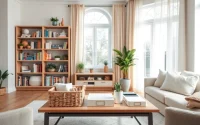Maximize Space and Style with Sliding Partition Walls for Your Home
Understanding Sliding Partition Walls
What is a Sliding Partition Wall?
A sliding partition wall is a versatile interior design solution that allows the separation and organization of space in both residential and commercial environments. Unlike traditional walls, which are fixed and permanent, sliding partition walls can move horizontally, providing flexibility in how spaces are defined and utilized. These walls operate on track systems or slides, enabling easy adjustment to accommodate various needs, whether for privacy, room function, or aesthetics. Given their dynamic nature, sliding partition walls can help optimize space in open-plan layouts, meeting the evolving demands of the modern user.
Benefits of Using Sliding Partition Walls
Sliding partition walls offer several compelling benefits that contribute to their growing popularity.
- Flexibility: These partitions can be easily reconfigured, allowing for the creation of temporary spaces that can adapt to different functions over time. For instance, a large meeting room can be divided into smaller discussion areas during peak usage, then restored to one expansive space afterward.
- Space Optimization: Sliding walls can effectively maximize the utility of smaller spaces. By enabling room divisions, they provide distinct areas for various activities without the permanence and thickness of traditional walls.
- Light and Sound Control: Depending on the material used, sliding partition walls can enhance acoustic privacy and control light flow, making them an ideal choice for environments requiring confidentiality, such as offices or meeting rooms.
- Aesthetic Appeal: Available in a range of materials, styles, and finishes, sliding partition walls can blend seamlessly with any interior decor, adding a modern touch while also serving functional purposes.
Applications in Residential and Commercial Spaces
Sliding partition walls find a multitude of applications across different settings:
- Residential: In homes, these walls are ideal for creating multi-functional rooms. For example, a living room can be transformed into a guest area by closing off part of the space at night.
- Commercial: In offices, sliding walls facilitate collaborative spaces that can be adjusted for meetings or presentations without needing to alter construction.
- Hotels: Sliding partitions can be used effectively to create adaptable spaces for conferences or events, catering to diverse group sizes and requirements.
- Retail: In retail spaces, they assist in creating visually captivating displays or temporary setups for special promotions.
Choosing the Right Sliding Partition Wall
Material Options: Wood, Glass, and More
When selecting a sliding partition wall, the choice of material plays a crucial role in determining its functionality and aesthetics:
- Wood: Offers warmth and a classic look, suitable for traditional and rustic spaces. It’s often used in residential settings.
- Glass: Provides an airy, open feel and allows natural light to flow through, making it perfect for modern and minimalist designs. Glass partitions are often favored in office environments for their sleek appeal.
- Metal: Typically used in commercial spaces due to its durability. Metal frames often support glass panels to create a contemporary industrial look.
- Composite Materials: These are engineered to combine aesthetics and functionality, providing unique finishes while being cost-effective.
Design Styles and Aesthetic Compatibility
The design of a sliding partition wall should complement the existing decor. Some popular styles include:
- Modern: Clean lines, minimalistic design, often with glass or sleek metal frames.
- Rustic: Features wood accents, often with distressed finishes, perfect for cozy homes.
- Industrial: Often includes elements like exposed metal frameworks, giving a unique vintage feel suitable for lofts and commercial spaces.
- Contemporary: A blend of styles, making it versatile for various settings, accommodating different tastes.
Cost Considerations and Budgeting
Budgeting for a sliding partition wall involves several factors:
- Material Choice: The selected material greatly influences the overall cost. Glass partitions often come with a higher price tag compared to wooden options.
- Installation Costs: Whether opting for DIY or hiring professionals, installation expenses can vary significantly based on complexity.
- Custom Features: Personalization options like finishes, hardware, and additional functionalities may impact costs as well.
Installation of Sliding Partition Walls
DIY Installation vs. Professional Services
Deciding between DIY installation or hiring professionals is a crucial step:
- DIY Installation: Ideal for those with a knack for home improvement, this option can save money. Many sliding partition wall systems come with comprehensive instructions that make it straightforward for someone with intermediate skills.
- Professional Installation: Hiring a contractor ensures that the wall is properly installed, especially for complex systems or when specialized tools are needed. This route may incur higher costs but can save time and offer peace of mind.
Step-by-Step Guide to Installation
Here’s a simplified step-by-step guide to install a sliding partition wall:
- Measure the Space: Determine where the wall will be placed and measure the width and height accurately.
- Purchase the Kit: Choose a sliding partition wall kit that fits your space and preferences.
- Prepare the Area: Clear the area of furniture and debris to work safely.
- Install the Track: Mount the track according to the manufacturer’s instructions, ensuring it’s level.
- Attach the Panels: Hang the sliding panels onto the track and make any necessary adjustments.
- Finishing Touches: Install any trim or hardware necessary to complete the look.
Common Challenges and Solutions
While installing sliding partition walls, challenges may arise:
- Misalignment: Ensure that tracks are level. Recheck measurements before finalizing installations.
- Hardware Compatibility: Always verify that hardware provided in kits matches with panels designed for your wall style.
- Weight Distribution: Heavier materials might require more robust tracks. Verify specifications to prevent premature wear.
Maintaining and Caring for Your Sliding Partition Wall
Regular Maintenance Practices
Maintaining sliding partition walls is essential for ensuring longevity and functionality:
- Check Tracks: Regularly inspect tracks for debris, ensuring smooth operation.
- Lubricate Mechanisms: Apply lubricant to sliding hardware to prevent sticking or jamming.
- Inspect for Damage: Routinely check for structural integrity and signs of wear, particularly for glass panels, ensuring safety and effectiveness.
Cleaning Tips for Different Materials
Different materials require different cleaning methods:
- Wood: Use a damp cloth and furniture cleaner to wipe surfaces. Avoid soaking the material.
- Glass: Use glass cleaner or a vinegar solution to remove smudges and keep surfaces clear.
- Metal: Wipe with a microfiber cloth and a mild cleaner to prevent rust or tarnishing.
When to Seek Professional Assistance
If issues arise that are beyond basic maintenance, consult professionals. This includes:
- Replacing panels or tracks.
- Addressing structural concerns.
- Complex adjustments or installations that require expert knowledge.
Innovative Ideas for Sliding Partition Walls
Creative Room Dividing Techniques
Get inspired by innovative configurations using sliding partition walls:
- Bookshelf Partitions: Use sliding bookshelves as partitions that not only divide space but also serve as functional storage.
- Cascading Panels: Create a dynamic space with panels that pivot or stack upon opening, offering flexible transitions between spaces.
- Decorative Screens: Combine aesthetics with functionality by using patterned screens that roll aside when not in use.
Integrating Technology with Sliding Walls
Innovative technology can enhance the functionality of sliding walls:
- Motion Sensors: Integrate sensors that automatically slide the walls open or closed based on occupancy.
- Remote Control Systems: Electric sliding walls can be operated remotely, providing convenience for large spaces.
- Smart Glass: Consider using smart glass technology that allows transparency control at the flick of a switch.
Real-Life Case Studies and Examples
Examining real-life applications can provide insight into effective design:
- Café Spaces: Many cafés have adopted sliding walls to create event areas—this allows for flexible use depending on the time of day.
- Corporate Offices: Leading companies utilize sliding walls for temporary meeting rooms, showcasing how adaptability can enhance productivity.
- Homes with Open Concepts: Families with open floor plans use sliding partition walls to create work-from-home spaces without permanent divisions.


